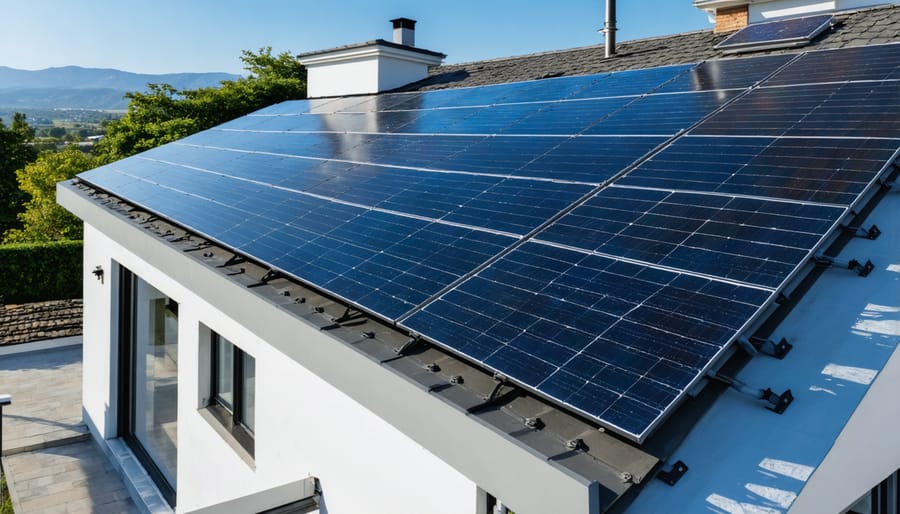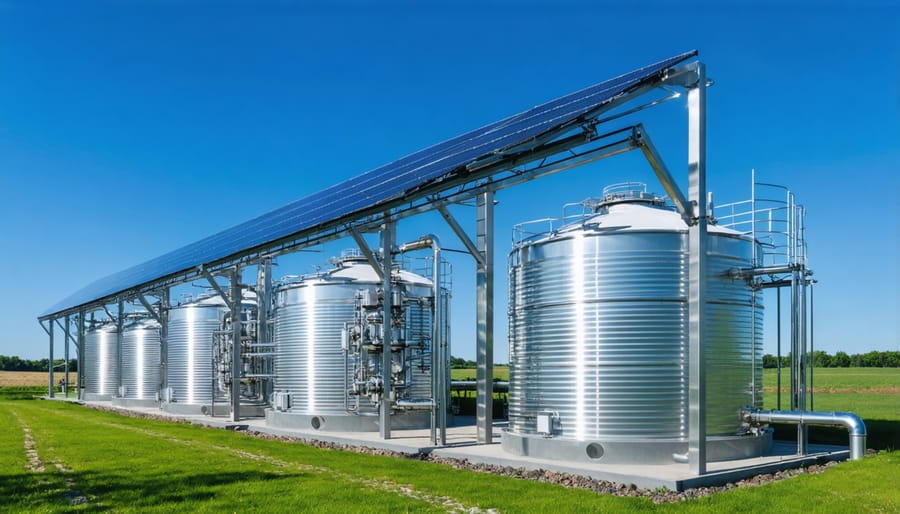Solar panels themselves don’t store energy – they generate it. This crucial distinction sits at the heart of modern solar power systems, where effective energy storage becomes just as important as generation. Across Australian rooftops, solar panels work tirelessly during daylight hours, converting sunshine into electricity that powers homes and businesses. But when the sun sets, that’s where renewable energy storage solutions become essential.
Think of solar panels as collectors rather than containers – they’re brilliant at harvesting solar energy but rely on separate storage systems, typically batteries, to save that power for later use. This understanding has transformed how Australians approach solar installation, with many households now viewing battery storage as a natural companion to their solar panel investment.
As our communities increasingly embrace renewable energy, grasping this fundamental concept helps make informed decisions about solar power systems. Whether you’re considering solar for the first time or looking to upgrade your existing setup, knowing that panels and storage work as partners rather than individual solutions is key to maximising your renewable energy investment.
How Solar Panels Actually Work with Energy
The Real-Time Nature of Solar Power
Picture a typical sunny day in Australia – your solar panels are working brilliantly, converting sunshine into electricity to power your home. But as the sun moves across the sky and eventually sets, this energy generation comes to a halt. This is the real-time nature of solar power that many new solar owners are surprised to learn about.
Solar panels are like direct converters rather than batteries – they transform sunlight into electricity as it happens, much like a calculator powered by a small solar cell. During peak sunlight hours, usually between 10 am and 2 pm in most Australian regions, your panels will produce their maximum output. However, on cloudy days, during early mornings, or after sunset, the energy production significantly decreases or stops completely.
This real-time generation pattern often creates a mismatch between when we produce solar energy and when we actually need it. Many Aussie households use most of their electricity in the morning before work and in the evening after returning home – precisely when solar production is lower or non-existent. This is why understanding energy storage solutions becomes crucial for maximising the benefits of your solar investment.
Grid Connection vs Energy Storage
When your solar panels generate electricity during the day, that power needs to go somewhere immediately. In Australia, most solar-equipped homes are connected to the electricity grid, which acts like a virtual battery. Excess energy flows into the grid, earning you feed-in tariff credits, while you can draw power from the grid when your panels aren’t producing enough.
The alternative is energy storage using batteries, which is becoming increasingly popular across Australian households. With battery storage, you can capture excess solar energy during sunny periods and use it during peak evening hours or cloudy days, reducing your reliance on the grid.
Think of it like collecting rainwater in a tank versus letting it flow into the mains water system. Grid connection is like having unlimited access to mains water, while battery storage is like having your own tank – giving you more control but requiring initial investment.
Each option has its benefits: grid connection offers simplicity and lower upfront costs, while battery storage provides greater energy independence and can protect against power outages. Many Aussie households are now choosing a hybrid approach, combining both solutions for maximum flexibility.

Home Battery Solutions for Solar Storage
Popular Battery Systems in Australia
In the Australian market, several battery systems have emerged as popular choices for solar energy storage. The Tesla Powerwall remains a household name, offering 13.5kWh of storage capacity and sleek design that many Aussie homeowners love. It’s particularly well-suited to our climate, with excellent thermal management for those scorching summer days.
LG Chem RESU batteries have also gained significant traction, especially in metropolitan areas. These compact units come in various sizes, from 6.5kWh to 16kWh, making them adaptable to different household needs. Many Australian families appreciate their reliability and straightforward installation process.
The Sonnen battery system, while relatively newer to our shores, has quickly become a favourite among environmentally conscious households. What sets it apart is its impressive 10,000-cycle warranty and smart energy management features that work brilliantly with our varying solar conditions.
For those looking for an Australian-made option, RedFlow’s ZCell stands out with its unique zinc-bromine flow technology. It’s especially popular in rural areas where temperature resilience and long-term storage capabilities are crucial.
BYD batteries have carved out their niche by offering excellent value for money without compromising on quality. Their modular design allows Aussie households to start small and expand their storage capacity as needed, making solar storage more accessible to budget-conscious families.
Cost and Return on Investment
Adding a solar battery storage system to your home solar setup represents a significant investment, but one that can pay off handsomely over time. In Australia, battery storage systems typically range from $8,000 to $15,000, depending on capacity and brand. While this might seem substantial, understanding the benefits of solar batteries helps put this cost into perspective.
The average Australian household can expect to recoup their battery investment within 5-10 years, depending on factors like energy consumption patterns, electricity rates, and available government incentives. Many states offer rebates and incentives that can significantly reduce initial costs. For instance, Victoria’s Solar Homes Program offers eligible households up to $2,950 off the cost of a battery system.
To maximise your return on investment, consider sizing your battery system based on your actual energy needs. A typical 10kWh battery system can store enough energy to power an average home through the evening and overnight, potentially saving $600-$1,000 annually on electricity bills.
Keep in mind that battery prices continue to fall as technology improves. While early adopters paid premium prices, current systems offer better value and efficiency. When combined with rising electricity rates and increasing feed-in tariff reductions, the financial case for battery storage becomes increasingly compelling for Australian households.
Installation and Maintenance
Installing home battery storage systems requires careful planning and professional expertise. While many Aussie solar installers now offer integrated battery solutions, it’s essential to start with a site assessment to determine the ideal location and system size for your needs.
The installation process typically takes 1-2 days and involves mounting the battery unit in a cool, dry area (usually garage or utility room), connecting it to your existing solar system, and installing a battery management system. Your certified installer will also set up the necessary safety equipment and monitoring devices.
Maintenance is relatively straightforward, but regular check-ups are crucial for optimal performance. Most modern lithium-ion batteries require minimal maintenance beyond occasional software updates and yearly professional inspections. Keep the battery area clean and well-ventilated, and monitor the system’s performance through your mobile app or display unit.
For coastal areas like the Gold Coast or Sydney’s Northern Beaches, consider additional protection against salt air. In hotter regions like Western Australia or Northern Territory, ensure proper ventilation and sun protection for your battery unit.
Remember to keep vegetation clear of the installation area and check for signs of wear or damage after extreme weather events. Most quality systems come with 10-year warranties, but proper maintenance can extend their lifespan significantly.
Alternative Energy Storage Methods
Thermal Energy Storage
Thermal energy storage is gaining traction in Australian homes as an innovative way to store excess solar energy as heat. This method works brilliantly in our climate, where we can capture the abundant sunshine during the day and use it later for heating and hot water needs.
The most common thermal storage system you’ll find in Aussie homes is the solar hot water system. These systems use solar collectors to heat water or a special thermal fluid, which is then stored in an insulated tank. It’s like having a giant thermos that keeps your water hot for when you need it!
More advanced thermal storage solutions use materials called phase change materials (PCMs), which can store and release large amounts of energy while changing from solid to liquid and back again. Think of it like a rechargeable heat battery – during the day, it absorbs excess solar energy, and at night, it releases this stored heat to warm your home.
For businesses and larger installations, molten salt storage systems are becoming increasingly popular. These systems can maintain high temperatures for extended periods, making them perfect for industrial processes or large-scale heating needs.
The beauty of thermal storage is its simplicity and reliability – there are no complex electronics or batteries to maintain, and the systems typically last for many years with minimal maintenance. Plus, they’re particularly effective in our climate, where we can make the most of our sunny days.

Virtual Power Plants
Virtual Power Plants (VPPs) are revolutionising how Australian communities approach energy storage and distribution. These innovative networks connect multiple solar-equipped homes and their batteries into a unified system that works like one large power station. Think of it as a neighbourhood team effort where everyone’s solar panels and batteries work together to support each other and the grid.
In communities across Australia, from suburban Sydney to regional Queensland, households are joining VPPs to maximise their solar investment. When you participate in a VPP, your home battery system becomes part of a larger network that can store and share energy more efficiently. During peak demand periods, the VPP can distribute stored energy where it’s needed most, helping to stabilise the grid and potentially earning participants additional income.
For example, in South Australia, thousands of households have joined the SA Virtual Power Plant, which has successfully reduced energy costs for participants while improving grid reliability. The system automatically manages energy flow, storing excess solar power during sunny days and releasing it during peak evening hours or cloudy periods.
VPPs also offer a practical solution for apartment dwellers and those who can’t install their own solar systems. By participating in community energy projects, these residents can still benefit from solar storage solutions while contributing to a more sustainable energy future.

Making the Right Choice for Your Home
Assessment Checklist
When choosing an energy storage system for your solar setup, consider these essential factors to ensure you make the right choice for your home:
Battery Capacity: Assess your daily energy consumption patterns and choose a system that can store enough power for your needs. Most Aussie households typically require between 5-15 kWh of storage capacity.
Battery Type: Compare lithium-ion, lead-acid, and flow batteries. While lithium-ion batteries are currently the most popular choice in Australia due to their reliability and compact size, each type has its advantages for different situations.
Installation Space: Ensure you have a suitable location that’s clean, dry, and well-ventilated. Most modern batteries can be wall-mounted or floor-standing, but you’ll need enough space for safe installation and maintenance access.
Future Expansion: Consider whether you might need to add more capacity later. Some systems are modular, allowing you to expand as your energy needs grow.
Warranty and Lifespan: Look for systems with at least 10 years warranty. Quality batteries should last 10-15 years with proper maintenance.
Smart Features: Check if the system includes monitoring capabilities, blackout protection, and compatibility with your existing solar inverter.
Local Climate: Our harsh Australian climate can affect battery performance, so choose a system rated for your area’s temperature range.
Budget vs Value: While upfront costs are important, consider the long-term value, including potential energy savings and feed-in tariff optimisation.
Technical Support: Ensure local support is available for installation, maintenance, and troubleshooting.
Government Incentives and Support
The Australian government actively supports the adoption of solar storage systems through various Australian green energy initiatives and rebate programs. Currently, homeowners can access the Small-scale Renewable Energy Scheme (SRES), which provides upfront rebates through Small-scale Technology Certificates (STCs) when installing solar systems.
Several states offer additional incentives specifically for battery storage. In South Australia, the Home Battery Scheme provides subsidies of up to $2,000 for installing home battery systems. Victoria’s Solar Homes Program includes a battery rebate of up to $2,950 for eligible households, while the ACT’s Next Gen Energy Storage program offers support per kilowatt of battery capacity installed.
Local councils across Australia have also introduced their own incentive schemes. Many offer interest-free loans or additional rebates to help residents overcome the initial investment hurdle. Some energy retailers provide special feed-in tariffs for households with battery storage systems, maximising the value of stored solar energy.
To access these incentives, homeowners typically need to use accredited installers and approved battery products. It’s worth checking with your local council and state government regularly, as new programs are frequently introduced to support Australia’s transition to renewable energy storage.
Solar panels are just the beginning of your journey towards energy independence. While they don’t store energy themselves, pairing them with battery storage solutions can transform your home into a sustainable powerhouse. By understanding how solar energy works and investing in the right storage system, you’re not just saving on electricity bills – you’re contributing to Australia’s renewable energy future. Whether you choose a Tesla Powerwall, a hybrid system, or another battery solution, the technology is ready and waiting. Take the next step today by consulting with local solar experts who can help design a system that meets your unique needs. Together, we can build a cleaner, more sustainable Australia, one solar installation at a time.
